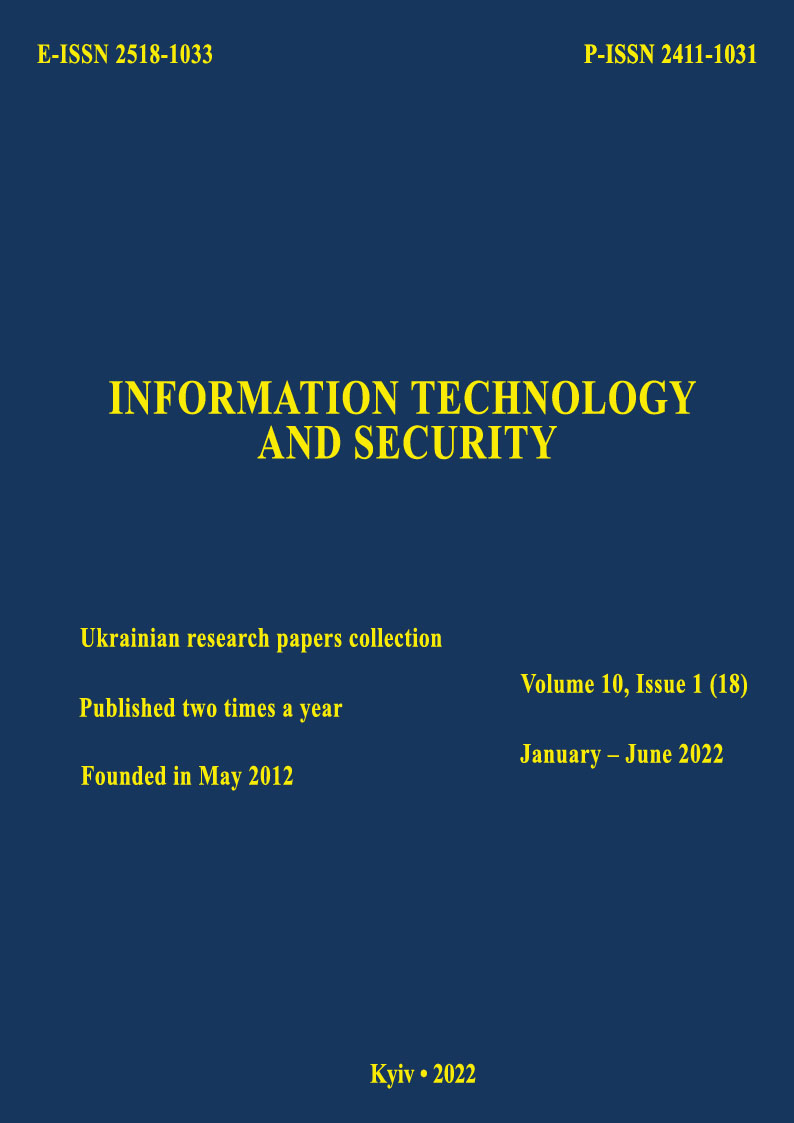Reliability models of telecommunication equipment facilities with non-replenishable or completely replenishable software failures
DOI:
https://doi.org/10.20535/2411-1031.2022.10.1.261132Keywords:
reliability models, telecommunication equipment, failures, software, time reserveAbstract
The main features of telecommunication equipment of modern communication networks include, first of all, that they are complex hardware and software complexes. Software, along with hardware (technical) part, has a significant impact on the reliability of telecommunications equipment of communication networks, as software failures and malfunctions often lead to no less serious consequences than hardware failures. The subject of theoretical research is the processes of operation of telecommunications equipment in conditions of limited reliability of software in order to build models of reliability of facilities, taking into account the use of non-replenishable time reserves to compensate for various types of failures. According to the nature of the consequences, all software failures can be divided into three groups: depreciated, partially depreciated and fully depreciate previous work. The result of building the reliability of telecommunications equipment with non-replenishing time reserve is to obtain analytical models that establish the relationship between indicators of reliability of facilities, characteristics of software failures and their consequences, as well as a set of technical parameters that determine the conditions its functioning. The essence of the novelty of these models is to jointly take into account the factors that compensate (reduce) the impact of software failures on the operation of telecommunications equipment, in particular, the use of non-replenishing time reserve, as well as breaking the tasks performed by objects successive stages with memorization of intermediate results and justification of the optimal number of stages. In the process of achieving the goal of the study was further developed differential method, the essence of which is to build a more general, compared to the known, model of three-dimensional homogeneous Markov process, which describes the operation of telecommunications equipment failures and malfunctions, some of which do not depreciate and part which completely devalues the previous development of telecommunications equipment that perform certain tasks.
References
V. Yakovyna, and V. Matseliukh, “Review and analysis of software reliability models”, Scientific Bulletin of the Lviv Polytechnic National University. Series: Computer science and information technology, pр. 130-140, 2017.
W. Zhong, L. Wang, Z. Liu, and S. Hou, “Reliability Evaluation and Improvement of Islanded Microgrid Considering Operation Failures of Power Electronic Equipment”, Journal of Modern Power Systems and Clean Energy, vol. 8, no. 1, pp. 111-123, 2020, doi: https://doi.org/10.35833/MPCE/2018.000666.
M. Haque, and N. Ahmad, “Key issues in software reliability growth models”, Recent Advances in Computer Science and Communications, vol. 13, no. 1, 2020, doi:https://doi.org/10.2174/2666255813999201012182821.
K. Raghuvanshi, A. Agarwal, K. Jain et al., “A time-variant fault detection software reliability model”, SN Appl. Sci. 3, 18, 2021, doi: https://doi.org/10.1007/s42452-020-04015-z.
P. Erto, M. Giorgio, and A. Lepore, “The Generalized Inflection S-Shaped Software Reliability Growth Model”, IEEE Trans Reliab, no. 69 (1), pp. 228-244, 2020.
V. Nagaraju, “Software Reliability Assessment: Modeling and Algorithms”, IEEE International Symposium on Software Reliability Engineering Workshops (ISSREW), Memphis, TN, pp. 166-169, 2018, doi: https://doi.org/10.1109/ISSREW.2018.000-4.
Y. Kim, K. Song, H. Pham, and I. Chang, “A Software Reliability Model with Dependent Failure and Optimal Release Time”, Symmetry, vol. 14, р. 343, 2022, doi: https://doi.org/10.3390/sym14020343.
M. Seniv, and O. Roik, “Techniques of calculating software reliability indicators based on models taking into account imperfect debugging ”, Scientific Bulletin of UNFU, vol. 6, pp. 87-91, 2021, doi: https://doi.org/10.36930/40310613.
V. Yakovyna, M.Seniv, I. Symets “Techniques of automated formulation of the condition of complex technical systems operability”, Scientific Bulletin of UNFU, vol. 29. no. 9, pp. 136-141, 2019, doi: https://doi.org/10.36930/40290924.
Yu. I. Hrytsiuk, and T. Mukha, “Methods for determining the quality of software”, Scientific Bulletin of UNFU, vol. 30. no. 1, pp. 158-167, 2020, doi: https://doi.org/10.36930/40300127.
D. Mogylevych, I. Kononova, B. Kredentser, and I. Karadschow, “Comprehensive Reliability Assessment Technique of Telecommunication Networks Equipment with Reducible Structure”, Scientific Bulletin NTUU KPI. Series: Radio engineering and Radio equipment construction, vol. 80, pp. 39-47, 2020.
D. Mogylevych, and I. Kononova, “Improved Estimates for the Reliability Indicators of Information and Communication Network Objects with Limited Source Information”, in Advances in Information and Communication Technologies. UKRMICO 2018. Lecture Notes in Electrical Engineering, M. Ilchenko, L. Uryvsky, and L. Globa, Eds., Springer, Champ., vol. 560, pp. 101-117.
Downloads
Published
How to Cite
Issue
Section
License
Copyright (c) 2022 Collection "Information Technology and Security"

This work is licensed under a Creative Commons Attribution 4.0 International License.
The authors that are published in this collection, agree to the following terms:
- The authors reserve the right to authorship of their work and pass the collection right of first publication this work is licensed under the Creative Commons Attribution License, which allows others to freely distribute the published work with the obligatory reference to the authors of the original work and the first publication of the work in this collection.
- The authors have the right to conclude an agreement on exclusive distribution of the work in the form in which it was published this anthology (for example, to place the work in a digital repository institution or to publish in the structure of the monograph), provided that references to the first publication of the work in this collection.
- Policy of the journal allows and encourages the placement of authors on the Internet (for example, in storage facilities or on personal web sites) the manuscript of the work, prior to the submission of the manuscript to the editor, and during its editorial processing, as it contributes to productive scientific discussion and positive effect on the efficiency and dynamics of citations of published work (see The Effect of Open Access).

